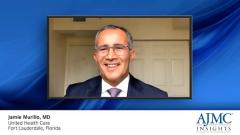
Heart Failure Sites of Care
A discussion on the optimal sites of care for patients with heart failure and how differing locations may alter treatment access.
Episodes in this series

Jaime Murillo, MD: Another good question is about the site of care where patients are first treated or first diagnosed for heart failure. Unfortunately, the hospital is usually the place where we find that patients have heart failure, either reduced or preserved. That provides another opportunity. I’m going to mention something that I have not said before, which is that we need to be better at preventing heart failure, either a new-onset diagnosis or exacerbation. We can talk about that later, but right now, the fact is that patients are put in the ED [emergency department], but there are also alternative sites like infusion sites where you can do IV [intravenous] diuretics without having to admit a patient. That has been a bit of—I don’t want to use the phrase gaming the system, because trying to prevent readmission is valid and fair. We can do a better job before we even have to take someone to an infusion center and prevent them from getting to that point. That’s an opportunity.
Obviously, for those who have access to care in the office with a brick-and-mortar approach where there’s a group that says, “I’m going to take ownership of this group of patients with heart failure,” that’s a very successful approach. I would also argue that it’s not scalable. We don’t have enough capacity to keep bringing patients to the office on a regular basis every time that is needed. There is a huge opportunity from that standpoint, and that’s why I talk about the digital access to make sure we monitor those patients, make sure they comply with the medications, and make sure they have access to providers when they have questions. If you ask me what the ideal site of care is, I would say it’s the home.
In general, in heart failure you can make the argument that this doesn’t necessarily affect the medications, except for places where they may have formulary restrictions. For the agents that we call the “$4-a-month medications,” this is not an issue. The patients have access to them, and they will benefit from them. For newer medications, there may be a limitation in terms of whether the formulary or hospitals offer that, and that’s whether there’s a class effect. Not everybody recognizes this on the health plan side. We have been proactive, to be honest, in terms of if we see benefits from the cardiovascular standpoint. We try to err on the side of saying, “Let’s take action and get it done” because there is a large population who could benefit, because there are enough randomized clinical trials to prove the benefit. We try to be more proactive and understand that there are economic limitations.
As a part of the P&T [pharmacy and therapeutics] committee, something that we do that you’ll be surprised to hear is that, when it comes to looking at the clinical merits of any specific medication, we never talk about money. We never say, “This is going to cost us X or Y.” I’m not going to say that it’s not talked about at our organization [United Health Care], because it’s obviously part of the health plan planning. But when it comes to making clinical decisions around formularies, we strictly base it on the existing literature and guidelines.
Newsletter
Stay ahead of policy, cost, and value—subscribe to AJMC for expert insights at the intersection of clinical care and health economics.































































